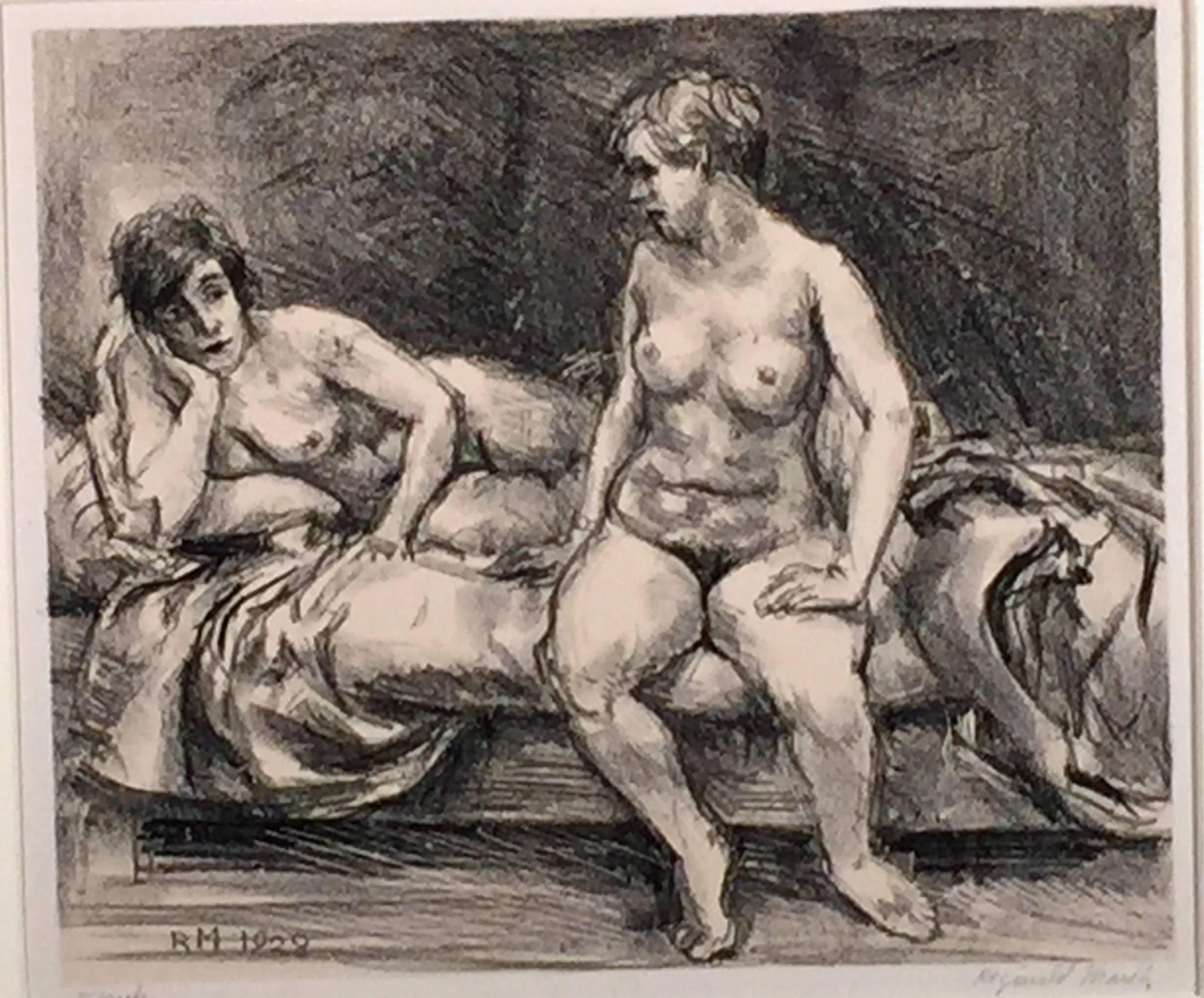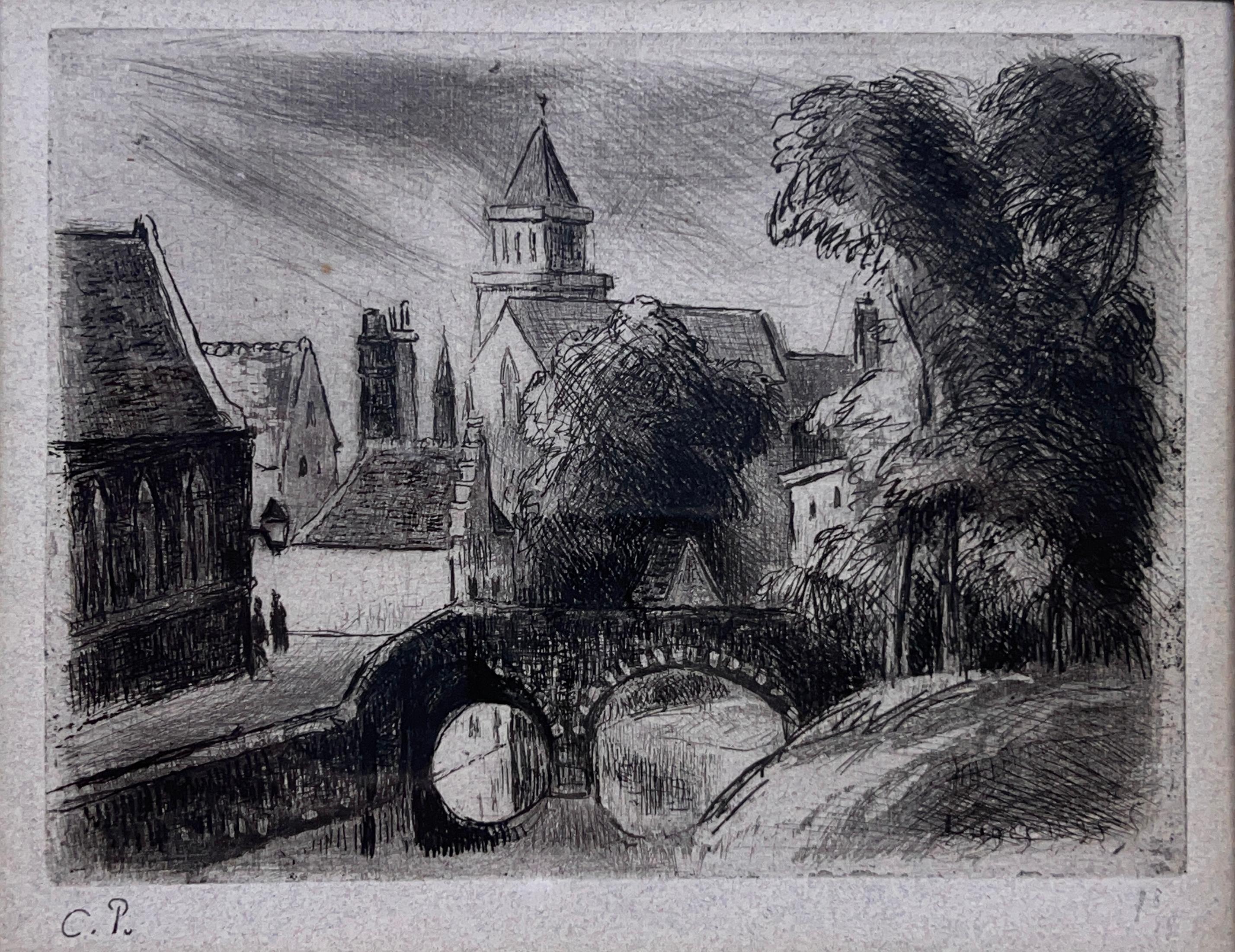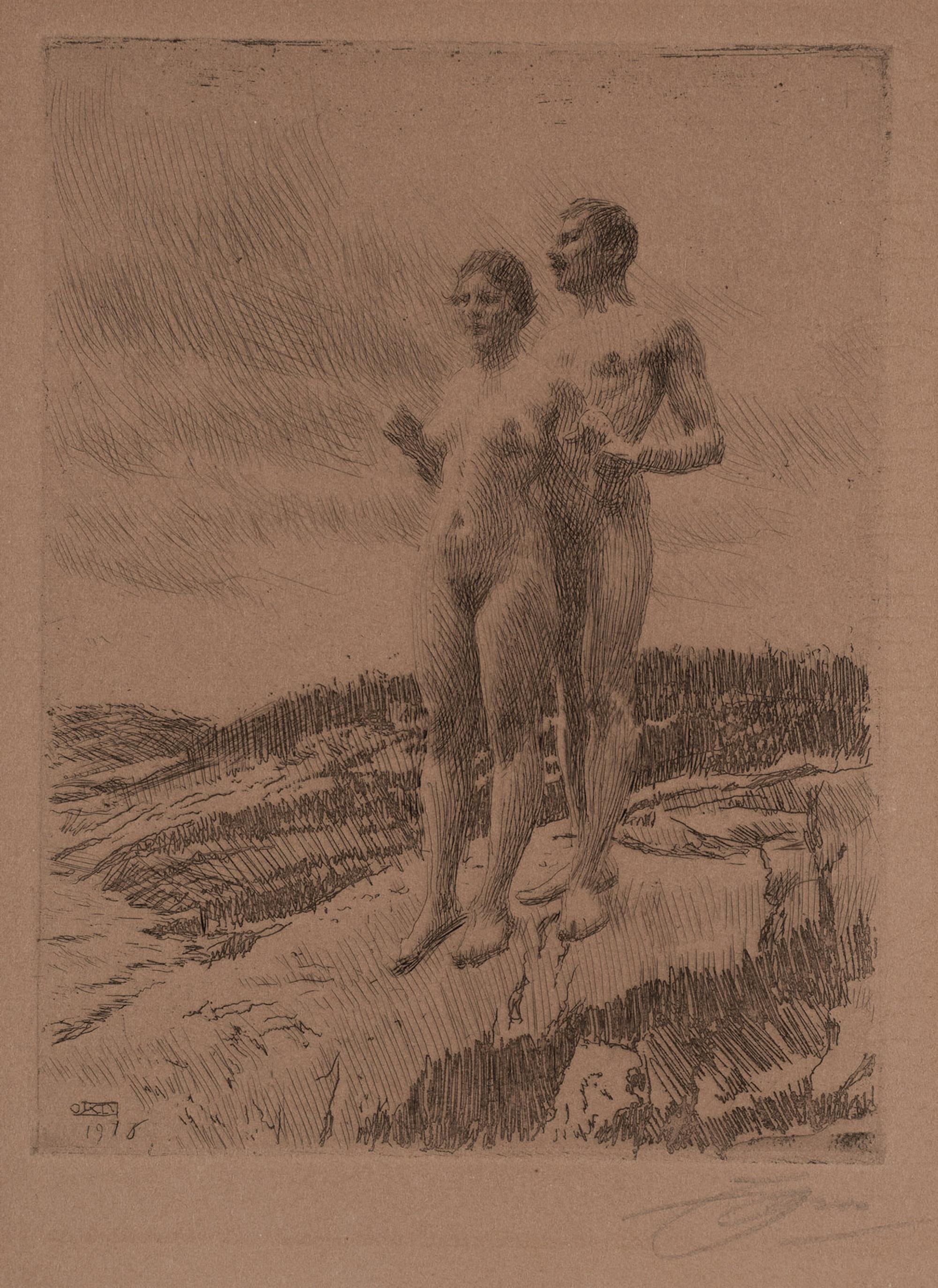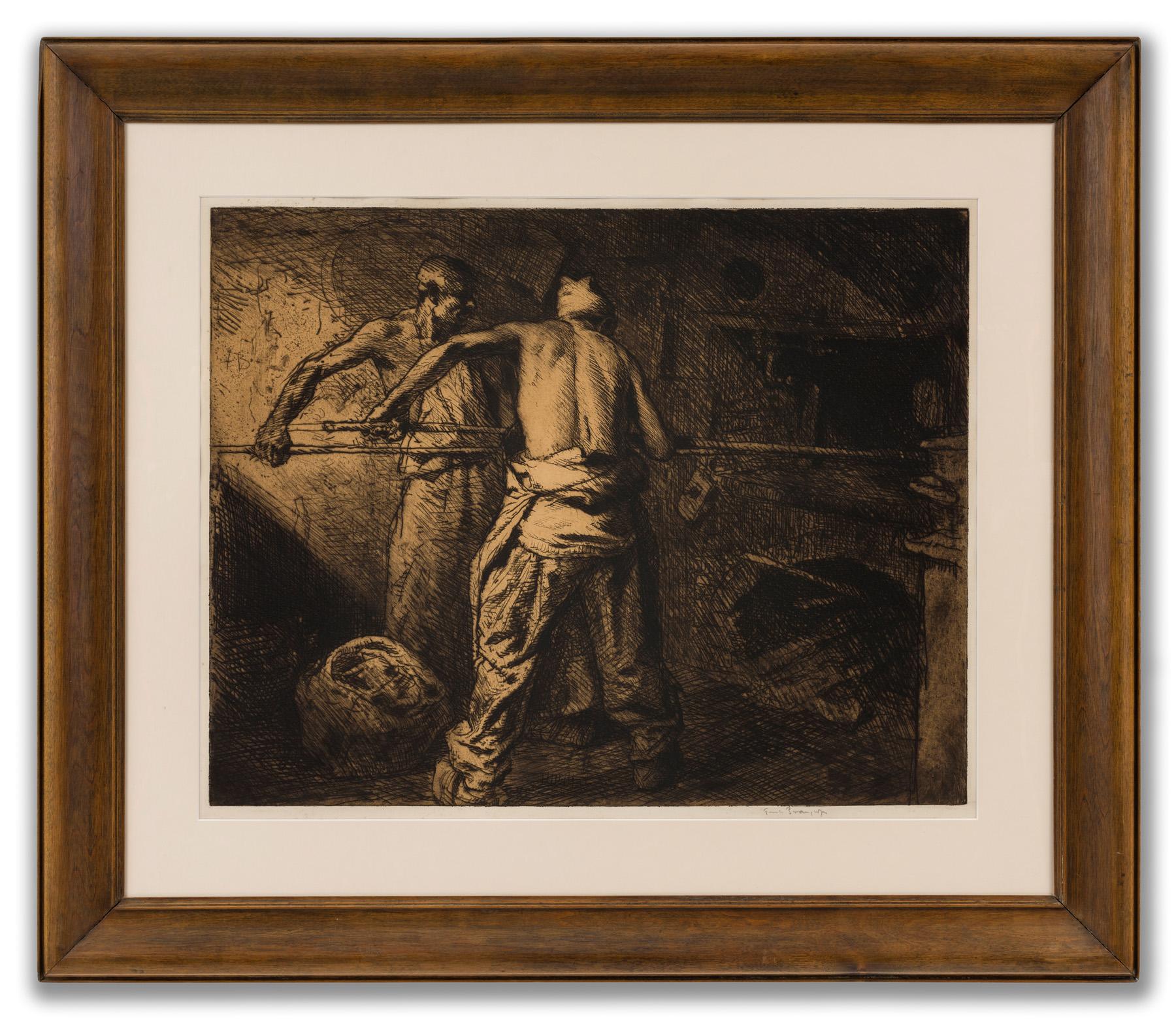Want more images or videos?
Request additional images or videos from the seller
1 of 3
John SloanNude at Piano1933
1933
About the Item
John Sloan, 'Nude at Piano', 1933, etching, edition 100, (only 85 printed), Morse 265. Signed, titled and annotated '100 proofs' in pencil. Signed and dated in the plate, lower right. A fine, richly inked impression, in warm black ink, on cream wove paper, with full margins (1 1/2 to 4 inches). Slight toning at the sheet edges, otherwise in good condition.
“A strong relationship between this etching and the painting of Renoir is to me quite noticeable. My own best results in painting of the nude are made with the same graphic intent” –John Sloan, from the catalogue Raisonné 'John Sloan's Prints', Peter Morse, Yale University Press, 1969.
Impressions of this work are in the permanent collections of the following institutions: Delaware Art Museum, Detroit Institute of Arts Museum, Library of Congress, Metropolitan Museum of Art.
ABOUT THE ARTIST
Dubbed the “dean of American artists,” John Sloan was one of the most influential members of the Ashcan School. Born in 1871 in Lock Haven, PA, he lived and worked in Philadelphia for most of his early career. Self-taught in etching, he additionally attended night classes at the Spring Garden Institute and enrolled at the Pennsylvania Academy of Fine Arts between 1892-1894, where he studied under Thomas Anshutz. Sloan began his career in commercial illustration in 1892 working for the Philadelphia Inquirer; later moving to the art department at the Philadelphia Press. A member of the ‘Philadelphia Five’, he frequently met with William Glackens, George Luks, Everett Shinn, and Robert Henri at Henri's studio. Henri had a profound influence on Sloan and encouraged him to pursue a fine art career. Sloan moved to New York City in 1904, then the nation’s cultural and intellectual center and the home of a flourishing art scene. He quickly came to love New York and described it as the “gayest of cities, the cosmopolitan palette where the spectrum changed in every side of the street.” Sloan’s subjects, as diverse and varied as the city itself, celebrated the lives of ordinary Americans in a way that was unprecedented in American art. He painted and etched New York’s great avenues and landmarks, the tenements of the Lower East Side, the sweeping vistas of the Manhattan skyline, the crowd of working-class men at McSorley’s Bar, the audience in the moving picture house, the election night festivities in Herald Square, and the trio of women drying their hair on a Sunday morning. Sloan’s images of New York provided a sprawling and comprehensive pictorial testament to urban life and culture. His student, Guy Péne du Bois aptly described him as the “historian of Sixth Avenue, Fourteenth Street, Union Square, and Madison Square.” Sloan was keenly aware of New York’s rapidly changing environment and acknowledged that “the fun of being a New York painter is that landmarks are torn down so rapidly that your canvases become historical records before the paint on them is dry.” Sloan’s works are particularly distinctive in the Ashcan genre due to his strong political commitments. In 1910, he joined the Socialist Party and in 1912 began creating illustrations for the popular socialist magazine ‘The Masses’. In spite of great economic prosperity, New York also presented the Ashcan artists with glaring inequalities between the classes. The city itself was physically divided by neighborhoods of grand mansions juxtaposed to poor immigrant communities and dilapidated slums. Sloan was undoubtedly influenced by the socially conscious art of the Mexican muralists Diego Rivera, David Alfaro Siqueiros, and José Clemente Orozco. Though he never espoused propaganda, his socialist beliefs resonate in his urban scenes and deeply sympathetic treatment of lower-class subjects. An esteemed art instructor, Sloan had a profound influence on his students. Beginning in 1914, he taught at the Art Students League and later at the George Luks School of Art. After his death, the art critic Edward Allan Jewel wrote: “He is the artist’s guide, philosopher and friend. He is himself the artist through and through. And he brings to the profession of teaching a fervor so intense that it may be described as mystical. There are, to be sure, many liberal and independent minds. There are many artists, many teachers. There is only one John Sloan.” John Sloan left a lasting mark on 20th-century American art and an important legacy for succeeding generations of American artists. After his death, Life Magazine asserted that no living man had a greater influence in the American Art world. His works memorialize a vibrant era of New York’s history and continue to be collected by every major museum including, Metropolitan Museum of Art, Whitney Museum of American Art, Brooklyn Museum, National Gallery of Art, Smithsonian Museum of American Art.
- Creator:John Sloan (1832-1932, American)
- Creation Year:1933
- Dimensions:Height: 6.88 in (17.48 cm)Width: 5.38 in (13.67 cm)
- Medium:
- Movement & Style:
- Period:
- Condition:
- Gallery Location:Myrtle Beach, SC
- Reference Number:
About the Seller
5.0
Recognized Seller
These prestigious sellers are industry leaders and represent the highest echelon for item quality and design.
Platinum Seller
These expertly vetted sellers are 1stDibs' most experienced sellers and are rated highest by our customers.
Established in 1995
1stDibs seller since 2016
254 sales on 1stDibs
Typical response time: 2 hours
Associations
International Fine Print Dealers Association
- ShippingRetrieving quote...Ships From: Myrtle Beach, SC
- Return PolicyA return for this item may be initiated within 7 days of delivery.
More From This SellerView All
- 'Le Paradis Terrestre' (Paradise on Earth) — 1930s SymbolismBy Edouard GoergLocated in Myrtle Beach, SCEdouard Goerg, 'Le Paradis Terrestre' (Paradise on Earth), etching, 1931, edition 40. Signed, titled, and numbered '3/40' in pencil. A fine richly-inked impression, on heavy, cream w...Category
1930s Symbolist Figurative Prints
MaterialsEtching
- The SerenadeBy Louis LegrandLocated in Myrtle Beach, SCA superb, richly-inked impression, with skilfully wiped plate tone and burr in the drypoint, printed in dark sepia ink on cream laid paper, with the Louis LeGrand watermark in the bo...Category
1890s Post-Impressionist Nude Prints
MaterialsDrypoint, Etching, Aquatint
- 'Baigneuse Debout, à Mi-Jambes' — French ImpressionismBy Pierre-Auguste RenoirLocated in Myrtle Beach, SCPierre Auguste Renoir, 'Baigneuse Debout, à Mi-Jambes (Woman Bathing, Standing Up to Her Knees in Water)', 1910, etching, edition not stated, Delteil 23. Unsigned as published. A fin...Category
1910s Impressionist Nude Prints
MaterialsEtching
- Baigneuse Debout, à Mi-Jambes — French ImpressionismBy Pierre-Auguste RenoirLocated in Myrtle Beach, SCPierre Auguste Renoir, 'Baigneuse Debout, à Mi-Jambes (Woman Bathing, Standing Up to Her Knees in Water)', 1910, etching, edition not stated, Delteil 23. Unsigned as published. A fin...Category
1910s Impressionist Nude Prints
MaterialsEtching
- The Drunkard in Spring —after Gustav Mahler's 'The Song of the Earth'Located in Myrtle Beach, SCArthur Paunzen, 'Der Trunkene im Frühling' (The Drunkard in Spring) from the suite 'Song of the Earth', etching, aquatint, and drypoint, 1920. Signed and titled in pencil. Signed in the plate, lower right. A fine, richly-inked impression, on cream, wove Japan paper; the full sheet with margins (2 1/4 to 4 1/4 inches), in good condition. Image size 12 3/8 x 9 1/8 inches; sheet size 19 5/8 x 13 5/8 inches. Matted to museum standards, unframed. ABOUT THIS WORK Pauzen’s suite of six etchings 'Das Lied von der Erde' (The Song of the Earth), published in 1920, was inspired by Gustav Mahler...Category
1920s Vienna Secession Figurative Prints
MaterialsEtching, Drypoint, Aquatint
- Modernist Nude — Atelier 17Located in Myrtle Beach, SCRussell T. Limbach, 'Untitled (Modernist Nude)', etching and aquatint, no known edition, c. 1930. Signed in pencil. A fine impression, on cream wove paper, with full margins (1 7/8 to 2 3/4 inches), in excellent condition. Image size 8 15/16 x 5 15/16 inches; sheet size 13 3/8 x 10 1/4 inches. Extremely rare. Matted to museum standards, unframed. Probably created when Limbach was in Paris (1928-1934), where he was exposed to modernist printmaking explorations at Stanley William Hayter’s 'Atelier 17'. ABOUT THE ARTIST Born in Massillon, Ohio, Russell Limbach...Category
1930s American Modern Nude Prints
MaterialsEtching
You May Also Like
- Marsh, Reginald. TWO MODELS ON A BEDBy Reginald MarshLocated in Portland, MEMarsh, Reginald. TWO MODELS ON A BED. Lithograph, 1928 (Sasowsky 9). 9 1/16" x 10 5/8." Signed in pencil and annotated "15 proofs." Only state. Excellent co...Category
1920s Ashcan School Nude Prints
MaterialsLithograph
- Quai des menetriers a brugesBy Camille PissarroLocated in Los Angeles, CA"Quai des Ménétriers à Bruges" is a remarkable etching created by the renowned French Impressionist artist, Camille Pissarro. This exquisite artwork captures the beauty and charm of ...Category
Late 19th Century Nude Prints
MaterialsAquatint, Etching
- The TwoBy Anders ZornLocated in Tallinn, EEAnders Zorn (Utmeland/Dalarne, 1860 - Mora/Sweden, 1920) The Two", 1916 Signed in pencil lower right and monogrammed and dated in the plate. Etching on laid paper. 35,5 x 23 cm; 20,2...Category
1910s Figurative Prints
MaterialsLaid Paper, Etching
- Personnages et NuBy Pablo PicassoLocated in ZEIST, UTPablo Picasso- Personnages et Nu Medium: Etching on laid wove paper. Printer & Publisher: Printed by Jacques Frélaut, 1960 Published by Galerie Louise Leiris, 1960 Dimensions: ...Category
1960s French School Nude Prints
MaterialsEtching
- Portfolio Metamorfosis IBy Louise BourgeoisLocated in Ljubljana, SIPortfolio Metamorfosis I. Original 7 etching, one with collage, 1999. Edition of 25 signed and numbered impressions on Arches paper. The entire portfolio is for sale. Louise Bourgeoi...Category
1990s Post-Modern Figurative Prints
MaterialsMixed Media, Etching
- Men in a BakehouseBy Sir Frank BrangwynLocated in London, GBEtching, signed in pencil (lower right), 51cm x 64.5cm (plate size) (81cm x 94cm framed). British painter, printmaker, draughtsman, and designer, the son of a Welsh architect who specialized in church furnishings and who was working in Belgium at the time of the boy's birth. In 1882–4 Brangwyn served an apprenticeship with William Morris, and like his master he was active in a variety of fields. He was an Official War Artist in the First World War, for example, he was one of the finest draughtsmen of the day and a skilful etcher and lithographer, and he made designs for a great range of objects (furniture, textiles, ceramics, glassware, jewellery, and so on); however, he became best known for his murals. His most famous undertaking in this field was a series of large panels on the theme of the British empire, commissioned by the House of Lords...Category
Early 1900s Aesthetic Movement Figurative Prints
MaterialsPaper, Etching





